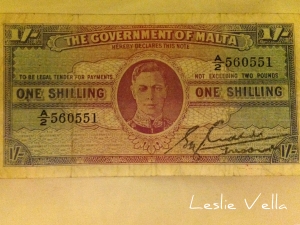Until the advent of the British in Malta in the early nineteenth century, the island’s currency consisted exclusively of coins. During the time of the Knights of St John, Malta minted its own coins with issues changing under each successive Grandmaster of the Knights.
The commencement of the British period in Malta’s history brought about the introduction of the Maltese banking system whose major objective was to facilitate trade between Malta and its trading partners, particularly in areas where the island was used to export British goods to traditionally inaccessible continental markets.
The introduction of paper currency was an intermittent affair, normally associated with the higher denominations. By and large people preferred coins, particularly at a time when silver and gold formed the basis of the high value coins. A currency’s worth was estimated in terms of its inherent metallic value rather than the symbolic value represented on a printed banknote.
Wars have a strange way of affecting rapid changes to things which would have otherwise been impossible to dislodge, and nowhere was this more true than in the case of Maltese currency banknotes.
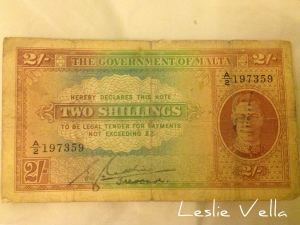 The first signs of change came during the First World War. A fear that stocks of British coins could not be replenished following the British declaration of war on Germany led to the widespread printing of the first ever Maltese banknotes for general distribution rather than use by the merchant classes. However these notes were withdrawn and replaced once again by coins after the initial panic subsided. Towards the end of the Great War in 1918, a hoarding of silver coinage by the Maltese population which was feeling the economic pain of reduced military expenditure, led to a temporary shortage of two and five shilling coins thus restricting commercial activity. The authorities printed significant quantities of banknotes for the two denominations, but the panic quickly subsided and the few notes which had been initially circulated were withdrawn and the remaining stocks were stored.
The first signs of change came during the First World War. A fear that stocks of British coins could not be replenished following the British declaration of war on Germany led to the widespread printing of the first ever Maltese banknotes for general distribution rather than use by the merchant classes. However these notes were withdrawn and replaced once again by coins after the initial panic subsided. Towards the end of the Great War in 1918, a hoarding of silver coinage by the Maltese population which was feeling the economic pain of reduced military expenditure, led to a temporary shortage of two and five shilling coins thus restricting commercial activity. The authorities printed significant quantities of banknotes for the two denominations, but the panic quickly subsided and the few notes which had been initially circulated were withdrawn and the remaining stocks were stored.
The commencement of hostilities during the Second World War posed a different problem. This time round, Malta was on the frontline and there was a genuine fear that Britain could not guarantee a steady flow of currency, especially given Malta’s lonely location as a British outpost surrounded by enemy territory in all directions.
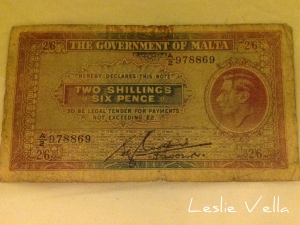 The solution to this state of affairs was practical and ingenuous. Paper currency issued in the name of the Government of Malta was once again designed, with six different notes for one shilling, two shillings, two shillings six pence, five shillings, ten shillings and one pound. Since there were no sophisticated printing presses available on Malta the notes were printed in the United Kingdom and shipped in different consignments to the island. Furthermore, to economise, the notes were only printed from one side.
The solution to this state of affairs was practical and ingenuous. Paper currency issued in the name of the Government of Malta was once again designed, with six different notes for one shilling, two shillings, two shillings six pence, five shillings, ten shillings and one pound. Since there were no sophisticated printing presses available on Malta the notes were printed in the United Kingdom and shipped in different consignments to the island. Furthermore, to economise, the notes were only printed from one side.
The dangers of transporting currency during a war are high, both because of losses if the ships transporting them are sent to the bottom of the sea and also in the event of the currency falling in enemy hands. While there was not much that could be done in the case of the first eventuality, the risk of currency falling in enemy hands was removed through the introduction of a simple, yet effective way. The Malta Government banknotes printed in Britain were not valid unless they were stamped with the signature of the Government’s Treasurer! Thus, arriving stocks of banknotes were further processed in small, hand-fed printing machines to add the Treasurer’s signature and make them valid legal tender. When the bombing became very intense, printing facilities were spread in different locations and at one point banknotes were even being stamped within the confines of a brewery!
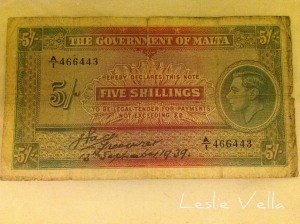 This notwithstanding, the Italian propaganda machine did its best to transmit the message to the Maltese population that Britain had effectively commandeered Malta’s currency stocks and replaced them with worthless printed paper: a message meant to turn the Maltese against their British masters and foment economic uncertainty.
This notwithstanding, the Italian propaganda machine did its best to transmit the message to the Maltese population that Britain had effectively commandeered Malta’s currency stocks and replaced them with worthless printed paper: a message meant to turn the Maltese against their British masters and foment economic uncertainty.
Notes were dispatched to Malta on naval and merchant ships, aircraft and even submarines and not all stocks made it here. For example when HMS Breconshire was sunk off Malta only 12,000 of the 84,000 one pound notes on board were recovered.
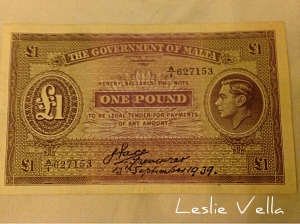 Although stocks of banknotes were generally adequate during the worst parts of the siege, there was a period between 1942 and 1943 when there was an acute shortage of one shilling notes. The solution to this problem was found when the Authorities discovered the old stock of unused two shilling notes from 1918 and overprinted them with a new one shilling denomination until replacement stocks arrived from Britain in 1943.
Although stocks of banknotes were generally adequate during the worst parts of the siege, there was a period between 1942 and 1943 when there was an acute shortage of one shilling notes. The solution to this problem was found when the Authorities discovered the old stock of unused two shilling notes from 1918 and overprinted them with a new one shilling denomination until replacement stocks arrived from Britain in 1943.
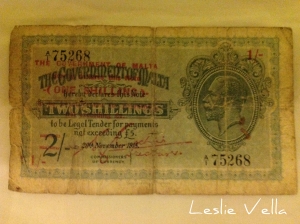 When we talk of war we tend to concentrate on stories related to bombings, hostilities, food shortages and battles. However it is also important to bear in mind that even during such horrible times life does go on, albeit at an abnormal pace, and economic needs remain as real as during times of peace. The availability of currency, standard or emergency, is of paramount importance to enable economic life to continue as normally as possible for during war people still need to earn, spend, buy and sell.
When we talk of war we tend to concentrate on stories related to bombings, hostilities, food shortages and battles. However it is also important to bear in mind that even during such horrible times life does go on, albeit at an abnormal pace, and economic needs remain as real as during times of peace. The availability of currency, standard or emergency, is of paramount importance to enable economic life to continue as normally as possible for during war people still need to earn, spend, buy and sell.
So, the hostilities of the Second World War not only brought us our first set of emergency paper banknotes for widespread use, but eventually made people get accustomed to the convenience of paper money in lieu of more cumbersome coins. This changing trend was formalized with the Paper Currency Ordinance of 1949 following which permanent banknotes denominated in a Malta Pound whose exchange rate was on par with the Pound Sterling were issued. The Malta Pound eventually evolved into the Maltese Lira until Malta joined the Eurozone in 2008.
